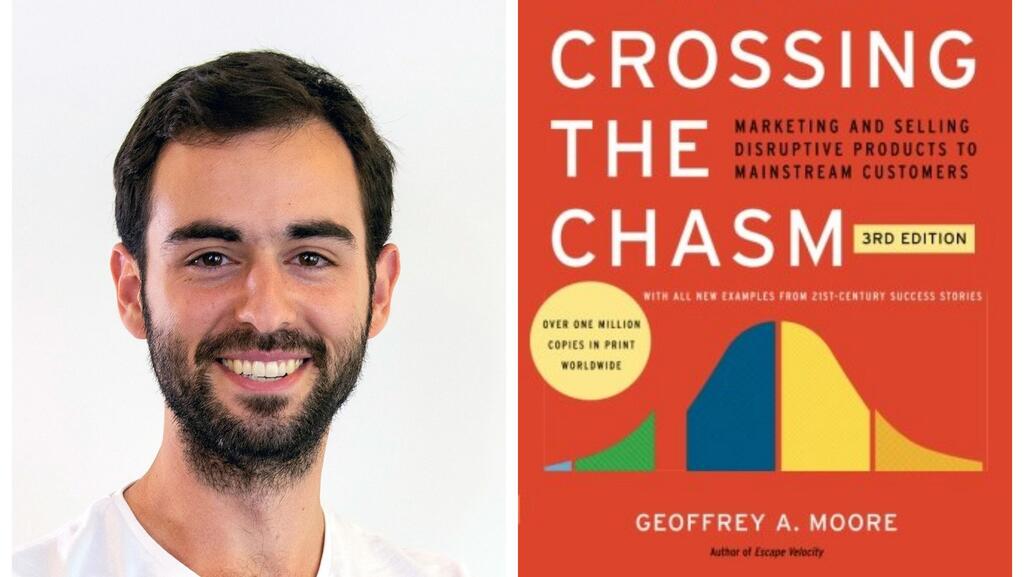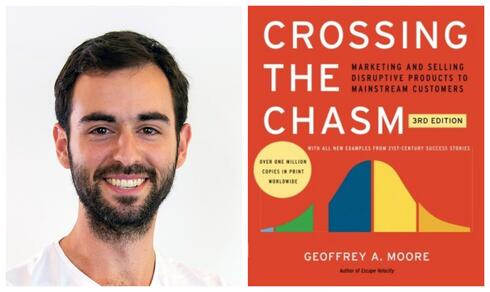
BiblioTech
CTech’s Book Review: The bible for early-stage entrepreneurs
Ran Ribenzaft, Co-Founder and CTO at Epsagon, shares insights after reading “Crossing the Chasm” by Geoffrey Moore.
Ran Ribenzaft is the Co-Founder and CTO at Epsagon (Acquired by Cisco), which simplifies modern cloud application development. He has joined CTech to share a review of “Crossing the Chasm” by Geoffrey Moore.
Title: “Crossing the Chasm”
Author: Geoffrey Moore
Format: Book
Where: Home
Summary:
The Bible for bringing products to large markets.
In “Crossing the Chasm”, Geoffrey A. Moore shows the Technology Adoption Life Cycle (TALC) concept. It includes innovators, early adopters, early majority, late majority, and laggards as segments you need to penetrate step by step.
Each step presents a different set of challenges and requirements, and Geoffrey focuses on the vast chasm between the early adopters and the early majority - where most companies fail.
Geoffrey presents that the challenge for innovators and marketers is to narrow that chasm to accelerate the adoption of the product ultimately. The book shares dozens of examples of both failures and successes.
Important Themes:
The segment chasm: According to Moore, there is a "chasm" - a gap - between the early market that startups aim to conquer in the early days and the mainstream market. Innovative products often flourish in the early market and then stagnate and die trying to accomplish in the mainstream.
Going from early market to mainstream: To win the early market, win the enthusiasts with a strong technology advantage that will become product credibility. Convincing skeptical pragmatists build the mainstream market through market leadership. One way to cross the chasm and become part of the mainstream market is to focus on a niche market. If you focus on a niche market, you are more likely to win and dominate it. Once you have this foothold, you can use it as a base for further expansion.
Position your product, company, and brand: Positioning refers to where potential customers place your product on the market landscape or how they view it compared to the competition. The early majority will position your product based on its reputation and market share. Hence, as you enter the mainstream market, your product's positioning will depend substantially on its reputation with key influencers and the perceived competition.
What I’ve Learned:
As a founder, I mainly learned that at each step of the startup and the product, the target market is different, and the expectations are entirely different. Getting to the first 12 early adopters will require cutting-edge technology, innovative product, and relatively simple positioning and messaging.
Winning the mass market is a problem that is 100 times harder since it requires remarkably good messaging and positioning. People should understand what you do and how it is different or unique compared to competitors.
A good tactic to build a good product is focusing on a niche market. A niche market does not necessarily mean small; it means focused. A focused market helps your product target and nail the personas and problems your product solves.
Related articles:
Once you reach product-market fit in a niche market, growing efficiently becomes much more manageable. While it's a vast chasm to cross and arguably the most challenging part every company face, when the foundation is built right, it becomes much more straightforward.
No doubt that things have changed remarkably since Moore first wrote “Crossing the Chasm”. The rate of new technology introductions has probably increased a lot since the first publication of the book, with businesses focusing on making technology products accessible and mainstream. Still, “Crossing the Chasm” contains many points which I believe are nearly timeless.
Finally, as Moore says: “Chasm crossing is not the end, but rather the beginning, of mainstream market development.” So this book teaches me the foundations of building a great company.
Critiques:
The book is so helpful and full of great insights. While it’s not a “fun” book, but almost considered as a “How to” guide, this book becomes very useful for anyone who wants to sell technology.
Despite the flaws, it’s a pleasure to accompany Geoffrey A. Moore on his journey through technology. For me, it was a road trip that led me to where I am today.
Who Should Read This Book:
In my opinion, it's the bible for any early-stage entrepreneur and tech lover. Nonetheless, this book can also fit any product, marketing, or tech person since the concept applies many aspects of strategic thinking in building and shipping products.
